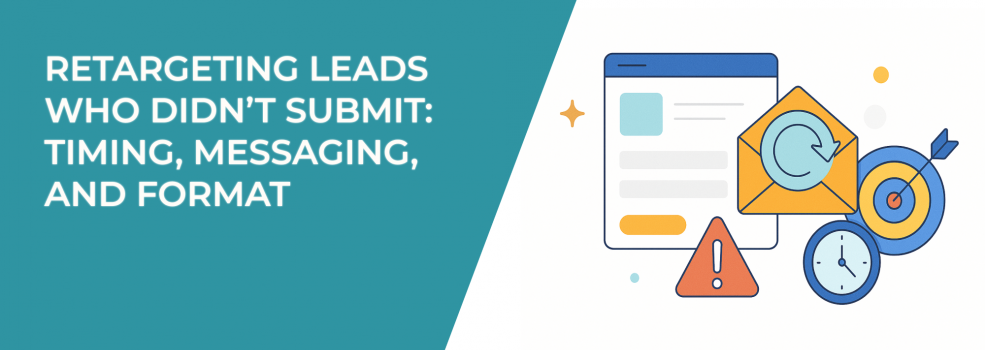Every marketer knows the feeling: you’ve invested in a well-crafted ad campaign, optimized your landing page, and driven high-intent users to your offer. Yet a significant portion of them leave without completing the form.
They were close — but something caused them to hesitate.
Retargeting these non-converting leads is not just a recovery tactic. When done well, it's one of the most cost-effective strategies for converting warm prospects into qualified leads. These users have already interacted with your brand, and with thoughtful follow-up, many will return and convert.
Let’s explore how to approach retargeting these non-submitters through precise timing, relevant messaging, and the right ad format while minimizing ad fatigue and wasted spend.
Why You Should Retarget Non-Submitting Leads
Visitors who landed on your lead form page but didn’t submit are demonstrating consideration-stage behavior. They’re no longer cold traffic — they’ve taken the time to learn about your offer. Whether they clicked from a social ad, a Google campaign, or an email, they engaged enough to get close to converting.
Unlike new audiences, these users don’t need to be educated from scratch. They need confidence. Clarity. A reason to return.
Here’s why they matter:
-
Higher intent: They’ve already interacted with your funnel. That makes them more valuable than top-of-funnel leads.
-
Lower acquisition cost: Retargeting campaigns tend to have lower CPCs than cold campaigns — especially when audiences are well-defined.
-
Better personalization: You already know which page they visited and when. You can use that to tailor messaging.
Ignoring these leads is like leaving warm money on the table. So how do you bring them back?
Step 1: Timing — When to Retarget Non-Converters
Effective retargeting starts with timing. The window between a visit and a retargeted touchpoint matters more than many advertisers realize. If you follow up too quickly, you risk being intrusive. Wait too long, and the lead goes cold.
Recommended Retargeting Timeline:
-
0–12 hours: Light, passive reminders work best. Consider serving a simple ad with minimal copy — perhaps a branded image or a “Did you forget something?” nudge. Focus on staying top of mind without overwhelming the user.
-
24–72 hours: This is your high-conversion window. Serve stronger messages that reinforce value, provide missing information, or address common objections. Highlight social proof, key benefits, or limited-time offers.
-
4–7 days post-visit: Introduce variety in format (video, carousel, testimonials). Change creative to avoid banner blindness. Adjust messaging to speak to hesitations — for example, emphasizing low commitment or risk-free trial options.
-
8–14 days: Begin throttling frequency. Users who haven’t converted by this stage may need a fresh angle or a new incentive. Use dynamic content to test different hooks.
-
15+ days: Consider excluding disengaged users or retargeting with a longer-term nurturing campaign (e.g., content download or newsletter signup).
Tip: use behavioral data such as session duration, scroll depth, and button interactions to determine lead quality. A user who spent 3 minutes on your page and clicked multiple CTAs should be retargeted differently than one who bounced in under 10 seconds.
Also, if you’re struggling to maintain performance while scaling or adjusting frequency, check out our breakdown of how frequency capping helps beat Facebook ad fatigue.
Step 2: Messaging — Match the Message to the Mindset
Your retargeting message should feel like a continuation of the conversation — not a hard reset.
To create high-performing retargeting messages, start by analyzing user behavior:
-
Did they view the pricing section and stop?
→ Focus on ROI messaging or offer a discount to lower perceived cost barriers. -
Did they reach the form but not fill it out?
→ Reassure them about the commitment. Emphasize quick setup, no credit card required, or flexibility. -
Did they engage with testimonials or feature lists?
→ Deliver case studies, customer success videos, or before/after comparisons.
Tips for effective messaging:
-
Be specific and clear. Vague or overly clever copy often falls flat. Focus on benefits that directly address known hesitations.
-
Use social proof. Quotes from happy clients or statistics about results build credibility. Real-world results resonate more than features.
-
Create urgency — but don’t fabricate it. Limited-time offers or capacity-based availability (e.g., “Only 5 demo slots left this week”) work well if they're legitimate.
-
Ask questions. Prompt curiosity with lines like:
-
“Still unsure if it’s right for your team?”
-
“Not ready to commit? Start with a free walkthrough.”
-
“Wondering how others in your industry use it?”
-
-
Reinforce trust. If you’re asking for contact info, reassure users. Mention security, privacy policies, and ease of opt-out.
Avoid repeating your original ad copy. If a user didn’t convert the first time, a fresh perspective is necessary.
Want to learn how to incorporate testimonials more effectively? Read this deep dive on the role of social proof in Facebook ads.
Step 3: Format — Choose the Right Creative Type
The format of your ad influences how it's perceived and how likely a user is to engage again. Certain formats perform better at different points in the retargeting cycle.
Format guidelines:
-
Image Ads:
-
Use for short, visual reminders.
-
Keep text minimal and focus on a single idea or benefit.
-
Use clear CTAs like “Finish Signing Up” or “See How It Works.”
-
-
Video Ads:
-
Ideal for explaining value in 15–30 seconds.
-
Use motion to recapture attention.
-
Consider user-generated content (UGC), founder messages, or animated demos.
-
-
Carousel Ads:
-
Use for storytelling, feature highlights, or comparison views.
-
Great for retargeting users who explored product pages.
-
Add progression: Frame 1 = problem; Frame 2 = solution; Frame 3 = testimonial; Frame 4 = CTA.
-
-
Lead Form Ads (again):
-
Retarget with a shorter or revised form.
-
Test lower-friction CTAs like “Book a call” or “Get instant access.”
-
-
Landing Page Variants:
-
Direct repeat visitors to an optimized, retargeting-specific landing page.
-
Use shorter copy, fewer distractions, and a refined CTA.
-
Pro tip: optimize for device. Mobile users respond better to vertical video, swipeable carousels, and minimal copy. Desktop users may be more open to detailed breakdowns and comparison charts.
Need inspiration for formats that fit different stages of the funnel? Here’s the ultimate guide to Facebook ad formats to help you choose wisely.
Step 4: Segment Your Retargeting Audiences
Precision matters. Treating all non-submitters the same will result in wasted impressions and lower performance. Instead, segment your retargeting audiences based on user behavior and context.
Valuable segments to build:
-
By intent level:
-
High: Viewed form, spent time on site, clicked CTA.
-
Medium: Scrolled but didn’t interact.
-
Low: Visited page, bounced quickly.
-
-
By page visited:
-
Product pages vs. pricing pages vs. blog posts.
-
-
By channel:
-
A lead from LinkedIn may need different messaging than one from YouTube.
-
-
By engagement:
-
Retarget those who interacted with video content, downloaded assets, or opened emails.
-
-
By device:
-
Test different creatives for mobile vs. desktop users.
-
Segmenting this way allows you to tailor messaging, creative, and offers to each group’s actual behavior.
If you want to go beyond standard segments, take a look at how to use behavior-based Facebook targeting for higher-quality leads.
Final thoughts
Retargeting leads who didn’t submit is about more than re-serving the same ad. It’s about identifying why the lead didn’t convert and offering the missing piece — whether that’s reassurance, clarity, a better CTA, or simply a second look.
Done right, retargeting campaigns:
-
Recover missed conversions with minimal additional spend.
-
Improve return on ad spend (ROAS) by nurturing leads already in your funnel.
-
Provide rich insights into what your audience cares about and where your messaging needs improvement.
So before you invest more in top-of-funnel growth, take a hard look at the leads who nearly converted. They might just need a smarter, sharper follow-up.

